Annual greenhouse gas emissions are at an all-time high, and urgent action must be taken to prevent catastrophic spikes in temperature and avoid the worst impact of climate change, according to a new report released on Thursday by the UN Environment Programme (UNEP).
In short, countries must start curbing emissions immediately, according to the UN Emissions Gap Report 2024.
“Climate crunch time is here,” said UNEP Executive Director Inger Andersen.
“We need global mobilisation on a scale and pace never seen before, starting right now before the next round of climate pledges.”
If not, she warned, the 1.5°C goal to cap rising temperatures set in the Paris Agreement on climate change “will soon be dead, and well below two degrees Celsius will take its place in the intensive care unit”.
Climate goals could evaporate
Launched at the COP16 global biodiversity conference in Cali, Colombia, the report tracks the gap between where global emissions are heading with current country commitments and where they ought to be to limit warming to well below 2°C and pursuing 1.5°C in line with the temperature goals set out in the 2015 Paris Agreement on climate change.
According to the report, the 1.5°C goal will be gone within a few years unless nations collectively commit to cut 42 per cent of annual greenhouse gas emissions by 2030 and 57 per cent by 2035 in the next round of nationally determined contributions and back this up with rapid action.
These self-defined contributions outline steps to reduce emissions and adapt to climate impacts – from drought, flooding and extreme weather events – securing necessary funds and updating plans every five years, the next time being in early 2025 ahead of the COP30 climate talks in Brazil.
‘Teetering on planetary tight rope’
Without dramatic cuts to greenhouse gas emissions, the world could face an inevitable and catastrophic 3.1°C temperature rise, according to the report, which comes at a time when governments are failing to fully deliver on their promises.
UN Secretary-General António Guterres said the emissions gap is not an abstract notion. Indeed, there is a direct link between increasing emissions and increasingly frequent and intense climate disasters.
“We are teetering on a planetary tight rope,” he warned in a video message. “Either leaders bridge the emissions gap or we plunge headlong into climate disaster, with the poorest and most vulnerable suffering the most.
Affordable technologies can help
The COP29 UN Climate Change Conference commencing in Baku, Azerbaijan, in November should serve as a launchpad for a detailed discussion of such new ambitious national plans, he said, saying that the event “starts the clock for countries to deliver new national climate action plans by next year”.
“Governments have agreed to align these plans with 1.5 degrees,” he said.
That means they must drive down all greenhouse gas emissions and cover the whole economy, pushing progress in every sector, he said, urging the largest economies – the G20 members responsible for around 80 per cent of all emissions – to lead in this process.
There is hope, the UN chief stressed.
“Today’s report shows affordable, existing technologies can achieve the emissions reductions we need to 2030 and 2035 to meet the 1.5°C limit, but only with a surge in ambition and support,” he said.
Clean energy can change trajectory
The report shows significant potential to reduce emissions by up to 31 gigatons of CO₂ by 2030, which translates to about 52 per cent of emissions reported in 2023, and by 41 gigatons by 2035, helping to meet the 1.5°C target for both years.
Boosting solar photovoltaic and wind energy usage could contribute 27 per cent of the total reduction in 2030 and 38 per cent by 2035. Additionally, forest conservation could provide around 20 per cent of the necessary reductions in both years.
Other effective strategies include enhancing energy efficiency, electrifying various sectors and transitioning from fossil fuels in buildings, transport and industry, according to the report.
However, the report stated that realising even a fraction of this potential will demand unprecedented international cooperation and a comprehensive approach from governments, focusing on maximising socioeconomic and environmental benefits while minimising trade-offs.

